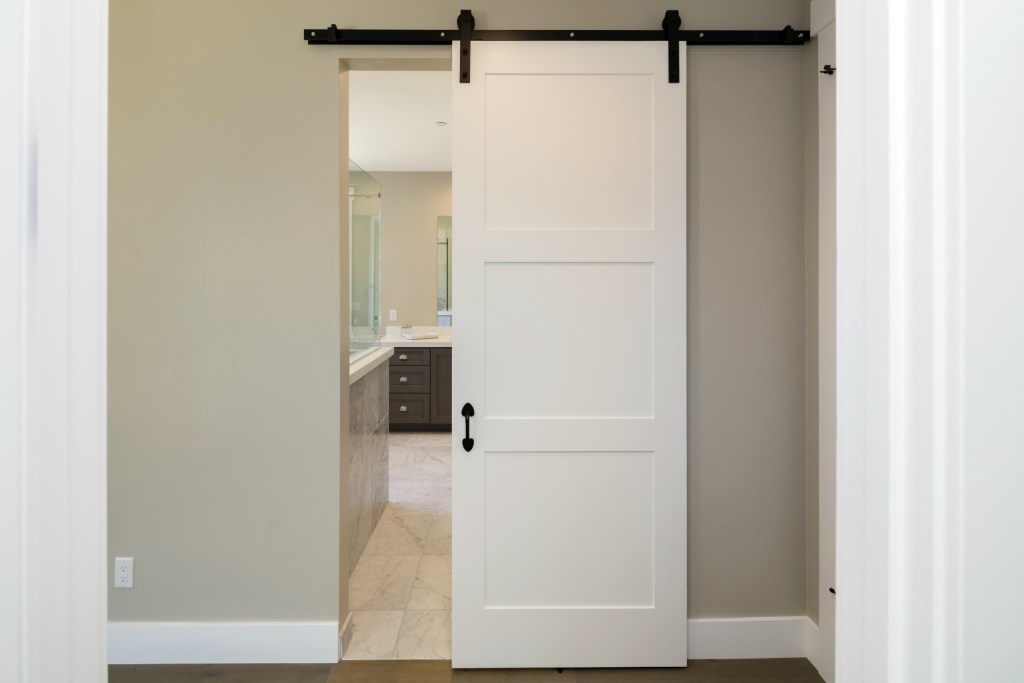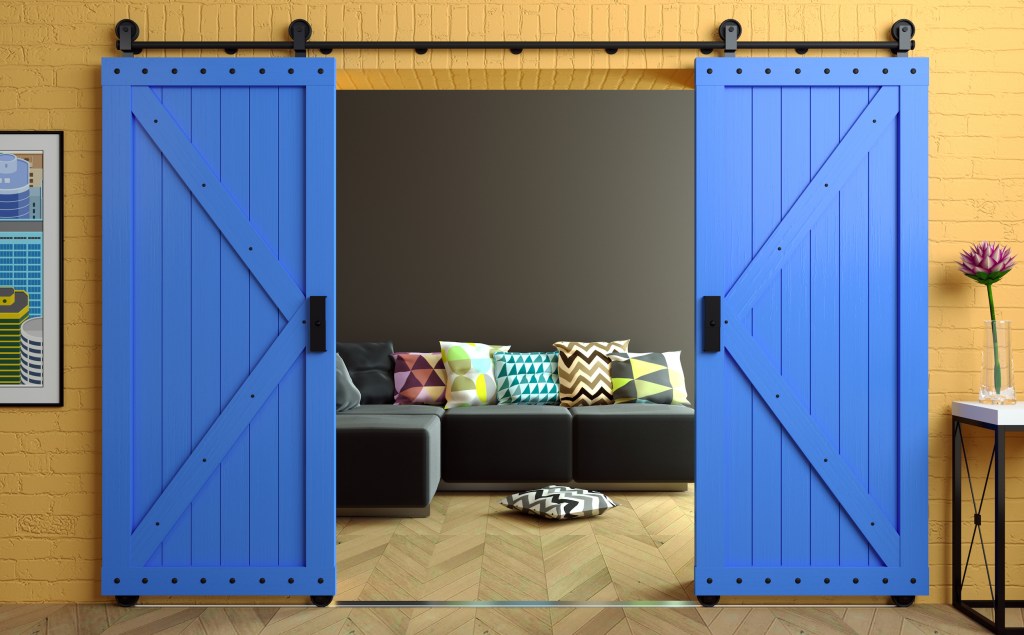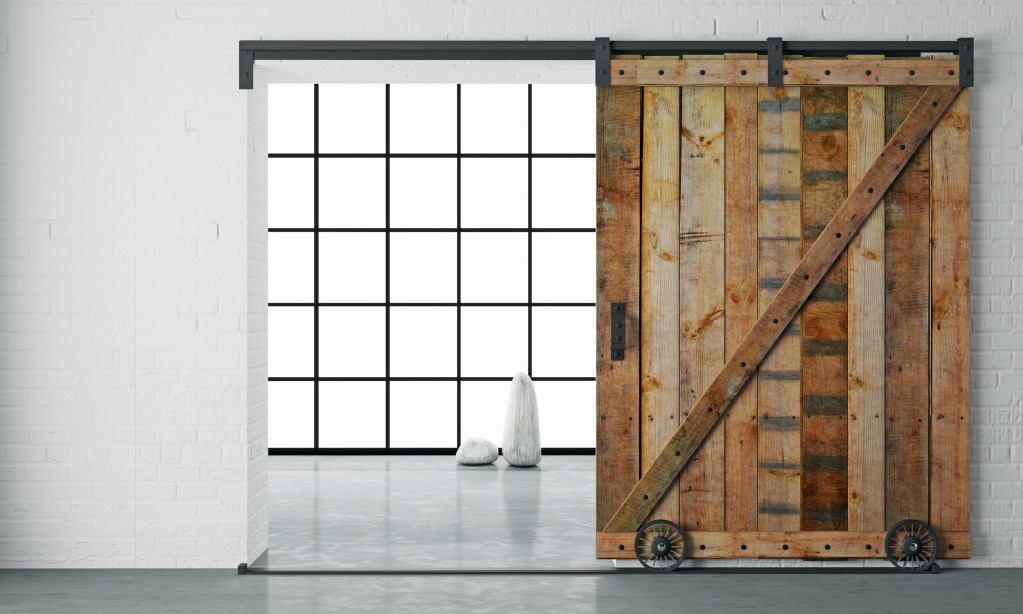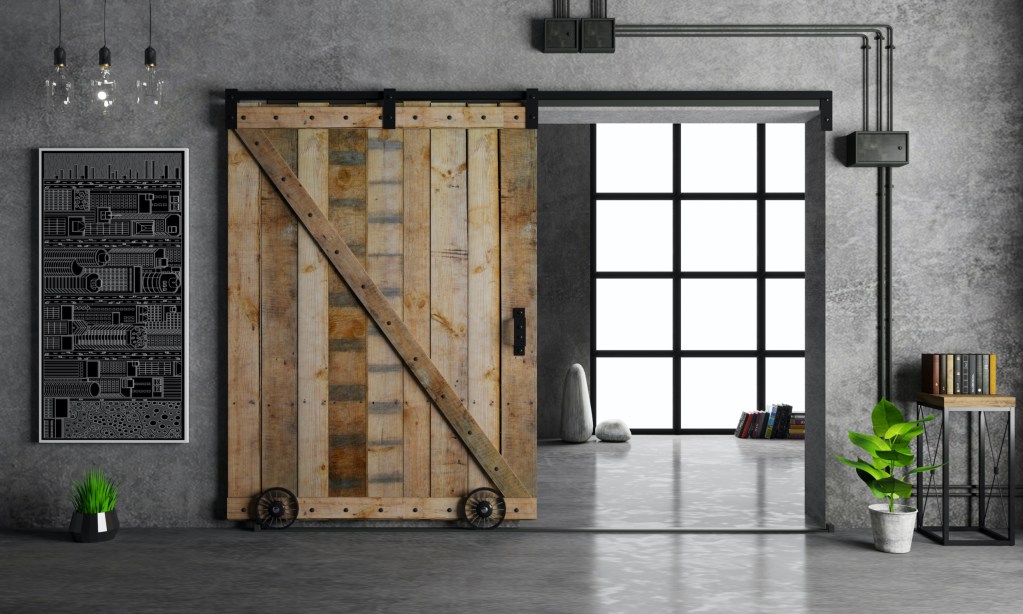
Sliding barn doors are a trendy, do-it-yourself design upgrade that can really transform your home’s aesthetic. In fact, the increased popularity of farmhouse-style homes has made sliding barn doors even more common than ever.
Basically, a sliding barn door is one that you can install anywhere in the home, and it’s usually a wood or metal material hung on a sliding track. Instead of opening and closing like a traditional door, it slides to the side and hangs neatly against the wall. People love them because they’re space savers, they can easily revamp a space, and they add lots of character to the room. Plus, installing sliding barn doors is pretty simple if you love to do DIY. But before you delve into the trend made famous by Magnolia’s Chip and Joanna Gaines, there are a few things you should take into consideration.

Trendy vs. timeless
While sliding barn doors have been around forever, they’ve definitely achieved the “trendy” status. And, like any trend, you should seriously consider your motivation before investing in sliding barn doors. There’s a big difference between genuinely loving a look and liking it because it is the “cool” thing of the moment.
Ask yourself questions like, “Am I still going to love these five years from now?” and “If I sell this house in a few years, is someone going to appreciate this?” If you can see long-term potential, then you’re good to go.

Pros of installing sliding barn doors
There are lots of benefits to installing sliding barn doors in your home.
- Space-saving option: Unlike traditional swinging doors that require clearance for opening and closing, sliding barn doors slide along a track, saving valuable floor space.
- Aesthetically pleasing: They add a unique and visually appealing element to any room. With a variety of styles, materials, and finishes, you can choose one that complements your interior design.
- Versatility and flexibility: They’re highly versatile and can be used in various settings. Barn doors can serve as room dividers, closet doors, pantry doors, or even simply as a decorative feature.
- Easy operation: Operating smoothly along a track system, barn doors are effortless to open and close. This makes them beneficial for individuals with mobility issues or those who prefer a hassle-free door mechanism.
- Durability and longevity: These doors are typically constructed using sturdy materials, such as wood, metal, or glass, making them a durable and long-lasting choice.
- Simple DIY installation: They’re a relatively simple DIY project, so you won’t have to hire a contractor (unless you’d prefer not to do this project yourself).

Cons of installing sliding barn doors
There are, however, some drawbacks to having sliding barn doors. For example, they do require enough extra wall space for them to roll along, and might potentially obscure any artwork you have on that wall. Here are some other cons to consider:
- Limited privacy and security: Sliding barn doors don’t provide the same level of privacy as traditional solid doors, and this may not be ideal for certain areas, like bedrooms or bathrooms that require a high level of privacy. They can also be easier to pry open or bypass compared to doors with traditional security lock mechanisms.
- Restricted insulation: These doors may not result in great thermal insulation like many traditional doors. Due to potential gaps between the door and the wall, air drafts can pass through, potentially affecting the room’s temperature and energy efficiency.
- Higher cost: They’re often more expensive than traditional doors, but the cost may vary depending on factors like the materials used, size, design, and hardware.

5 questions to ponder beforehand
Before making this change in your home or undertaking such a project, there are some essential questions to ask yourself. These questions can help you decide whether installing sliding barn doors is the right choice for you.
Do sliding barn doors work in your home?
You should always take into consideration your home’s style before embarking on any home renovation project. Traditional barn doors can look great in a farmhouse style, coastal, or even traditional home. However, if you install them in a mid-century or modern home, they will look seriously out of place.
There are also lots of different types of sliding barn doors, all offering a different look. For example, a more minimalist home might benefit from metal French-style sliding barn doors, while a modern home would be better suited with a more streamlined design.
Will you have enough privacy?
Before you consider installing DIY barn doors, Cynthia Peller Hum, an associate at Hirsch Bedner Associates, the global leader in hospitality interior design, reveals two major details to keep in mind: Sound and privacy.
Unlike a traditional door, sliding barn doors don’t block out the majority of sound. “Don’t forget, you will hear more sound through a sliding barn door than a traditional swing door since the edge isn’t sealed as tight,” Hum points out.
As far as privacy goes, you won’t be able to lock a sliding barn door in place as easily, which could be annoying if you are trying to keep your family or roommates out. If you are installing the barn door in the entryway to a bathroom or bedroom, consider hook and eye closures or a latch with a strike plate for more privacy.
Is your door header proportionate?
Before tackling this sliding door installation project (and to avoid costly home DIY mistakes), you need to keep in mind that a proportionate header is key, says Hum. A header is a solid piece of wood that anchors your barn door, helping to distribute the weight of the door and adding stability. It also adds aesthetic value.
“When detailing the opening, a proportionate header is key for decorative hardware,” Hum notes. “I find a simple block-finished edge without extra decorative trim is easiest to achieve, and it creates a clean, modern-cased opening for the barn door to be the main accent.”
Barn doors can weigh up to 200 pounds (or more), so headers are also important for sturdiness. Mount the header to wall studs (and make sure there are wall studs at every interval on your track).
Is your hardware coordinated?
Coordinating hardware on a barn door has less to do with aesthetics and more to do with function.
“Remember, the hardware and door must extend past the opening, so you have to make sure you have the space and be sure to position the hardware so the door will slide past the wall base,” Hum explains. “The door needs to be wider than the opening and the hardware on the outer edge.”
She adds that it’s especially important to coordinate the hardware and pulls, “For example, so the decorative pull doesn’t hit the frame.” Hum also recommends adding a stop on the track so fingers don’t get crushed.
Is this a good long-term investment for your home?
Another thing you’ll want to ask yourself is whether adding a sliding barn door to your home will be a good long-term investment. In the past, some designers would advocate for homeowners to add a sliding barn door to the house to raise the resale value. However, as the barn door trend began to fade, many homeowners noticed that one door may not influence resale value too much.
However, for homeowners who want to personalize their space while they’re still living in the home and who don’t plan to sell anytime in the near future, this question will apply to long-term happiness instead. Is the sliding barn door something you and your family will enjoy for the next few years? Does it suit your personal style? Or is it a fad that may pass? While barn doors are trendy, that doesn’t mean you have to hop on the bandwagon if it’s something you don’t think you’ll want in the long term. However, if you’re in love with the aesthetic and have often been drawn to similar styles within your design process, maybe this would be the perfect long-term investment for you.
Sliding barn doors can add an infusion of style to your home. Just remember, if you do decide to install one, planning is key. And if you decide sliding barn doors aren’t for you, there are plenty of other ways you can achieve a farmhouse look, whether you’re renovating a bedroom, living room, or the entire house.



